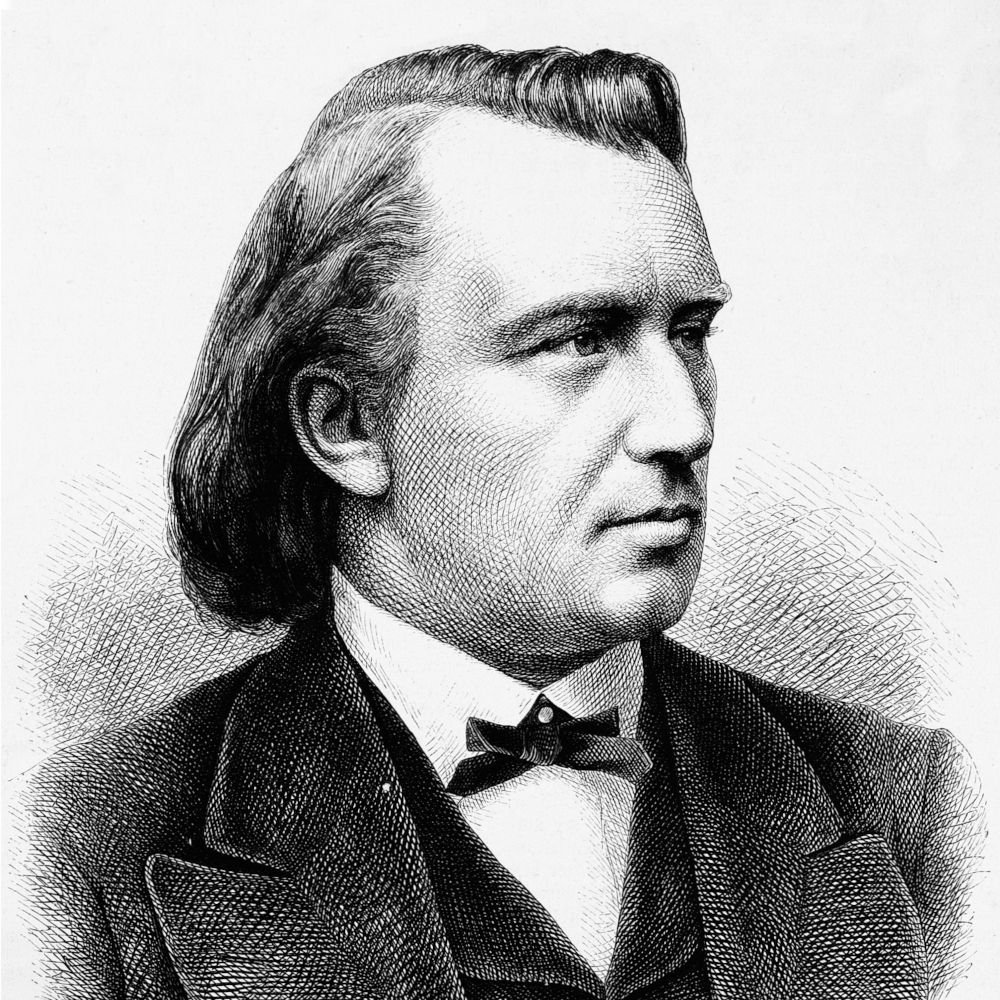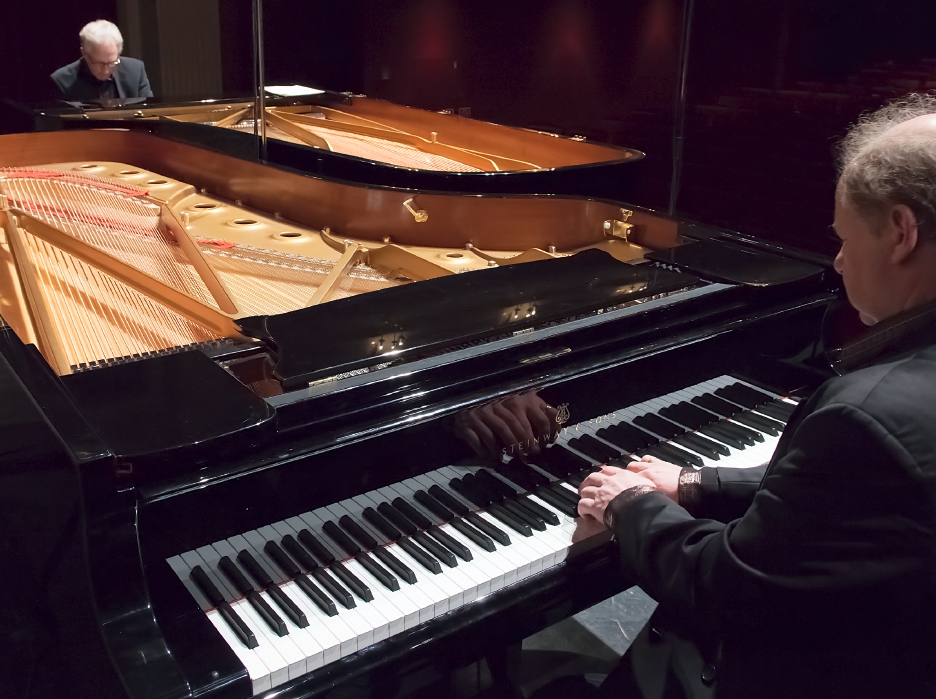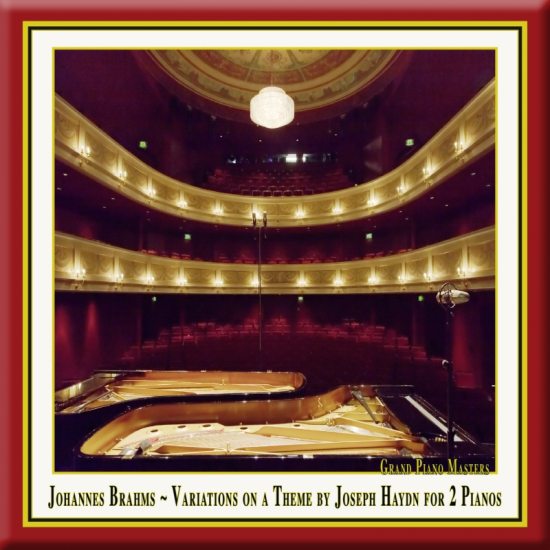BRAHMS: Variations for 2 Pianos, Op. 56b
Track
Variations for 2 Pianos
Op. 56b
Variations for two pianos on a theme by Joseph Haydn, Op. 56b
"Saint Anthony Variations"
Performed live by Rolf Plagge and Wolfgang Manz ("Duo Reine Elisabeth")
on 2 Concert Grand Pianos D-274 by Steinway & Sons
A live recording from the City Theater Kempten (Germany), March 16th 2012
HD Recording · DDD · Duration: 16 Min. 11 Sec.
Digital Album · 10 Tracks
MP3 · 320kBit/sec.
MP3 · 320kBit/sec.
MP3 · 320kBit/sec.
MP3 · 320kBit/sec.
MP3 · 320kBit/sec.
MP3 · 320kBit/sec.
MP3 · 320kBit/sec.
MP3 · 320kBit/sec.
MP3 · 320kBit/sec.
MP3 · 320kBit/sec.
MP3 Album
320 kBit/sec.



T
he Variations on a Theme by Joseph Haydn, (German: Variationen über ein Thema von Jos. Haydn), now also called the Saint Anthony Variations, is a work in the form of a theme and variations, composed by Johannes Brahms in the summer of 1873 at Tutzing in Bavaria. It consists of a theme in B-flat major based on a "Chorale St Antoni", eight variations, and a finale. The work was published in two versions: for two pianos, written first but designated Op. 56b; and for orchestra, designated Op. 56a.
The orchestral version is better known and much more often heard than the two-piano version. It is often said to be the first independent set of variations for orchestra in the history of music,[1] although there is at least one earlier piece in the same form, Antonio Salieri's Twenty-six Variations on 'La folia di Spagna' written in 1815. Brahms's orchestral variations are scored for piccolo, 2 flutes, 2 oboes, 2 clarinets, 2 bassoons, contrabassoon, 4 horns (2 in E flat, 2 in B flat), 2 trumpets, timpani, triangle, and the normal string section of first and second violins, violas, cellos and double basses. The piece usually takes about 18 minutes to perform. The first performance of the orchestral version was given on 2 November 1873 by the Vienna Philharmonic Orchestra under Brahms's baton.
Brahms composed the work on a theme entitled "Chorale St. Antoni" found in a wind ensemble composition. At the time Brahms discovered it, the wind ensemble piece carried an attribution to the composer Joseph Haydn. Brahms titled his own composition accordingly, crediting Haydn for the theme, but publishers in the early nineteenth century often attached the names of famous composers to works by unknown or lesser known composers in order to move inventory. Subsequent research has concluded that the wind piece Brahms used as a source does not fit Haydn's style. Today the wind ensemble piece remains without clear attribution. The situation has led to Brahms's piece being referred to today in recordings and concert programs as the St. Anthony Variations as well as its original title.
A detailed survey of the controversy can be found in Douglas Yeo's 2004 edition of the "Haydn" piece (ISMN M-57015-175-1).[2] In 1870, Brahms's friend Carl Ferdinand Pohl, the librarian of the Vienna Philharmonic Society, who was working on a Haydn biography at the time, showed Brahms a transcription he had made of a piece attributed to Haydn titled Divertimento No. 1. The second movement bore the heading "St. Anthony Chorale," and it is this movement which, in its entirety, forms the theme on which the variations are based. Brahms's statement of the theme varies in small but significant ways from the original, principally with regard to instrumentation. Some sources state the Divertimento was probably written by Ignaz Pleyel, but this has not been definitely established. A further question is whether the composer of the divertimento actually wrote the "St. Anthony Chorale" or simply quoted an older theme taken from an unknown source. To date, no other mention of a "St. Anthony Chorale" has been found.
The theme begins with a repeated ten-measure passage which itself consists of two intriguing five-measure phrases, a quirk that is likely to have caught Brahms's attention. Almost without exception, the eight variations follow the phrasal structure of the theme and, though less strictly, the harmonic structure as well. Each has a distinctive character, several calling to mind the forms and techniques of earlier eras, with some displaying a mastery of counterpoint seldom encountered in Romantic music.
The finale is a magnificent theme and variations on a ground bass, five measures in length, derived from the principal theme. Its culmination, a restatement of the chorale, is a moment of such transcendence that the usually austere Brahms permits himself the use of a triangle.
Just before the end of the piece, in the coda of the finale, Brahms quotes a passage that really is by Haydn. In mm. 463-464, the violas and cellos echo the cello line from m. 148 of the second movement of the latter's "Clock" Symphony, one of the finest examples of Haydn's pioneering work in the symphonic variation form. The reader may compare the two passages by following these links: Brahms, Haydn (see below for link credits). Ironically, this fragmentary allusion may be the music's sole link to Haydn.
Notes:
[1] McCorkle, Donald M., p. 5 in the Norton Scores edition of the Variations (ISBN 0-393-09206-2)
[2] Yeo, Douglas (2013). "Divertimento (Feldparthie) in B flat [St. Antoni Chorale], Hob. 2:46". yeodoug.com. Retrieved November 9, 2013.
From Wikipedia, the free encyclopedia

R
olf Plagge and Wolfgang Manz came to prominence after their remarkable successes at international piano competitions such as Leeds, Brussels, Warsaw and Moscow where they won major prizes. Today they belong to the most distinguished pianists of their generation. Both have completed their studies at the renowned "Hochschule für Musik und Theater" in Hanover; both have received many rewards and various scholarships.
Apart from their extensive activities as soloists in Germany and abroad, Rolf Plagge and Wolfgang Manz formed a piano duet in 1988 called Duo "Reine Elisabeth", in commemoration to the world-famous piano competition "Concours Reine Elisabeth" in Brussels, Belgium, in which their successful participation in 1983 and 1987 launched their international careers.
The DUO has performed in several European countries as well as in Middle and South America (Chile, Mexico). Both pianists have played together with famous conductors like Bernhard Klee, Pierre Bartholomée, Christian Kluttig, Frank Beermann and others.
There is a large repertoire available reaching from the baroque style to the classic, romantic and modern eras. Apart from classical and romantic programmes both pianists also feature works of contemporary composers such as Volker Blumenthaler, Richard Heller, Karl Thieme, Frédéric van Rossum, Daniel Capelletti or Piet Swerts. A special achievement of the DUO is the performance of rare transcriptions of well-known orchestral works and ballets: Igor Stravinsky's "Petrushka", "Le Sacre du Printemps", Franz Liszt's version of the Ninth Symphony of Beethoven for 2 pianos, Aram Chatchaturjan's ballets "Gayaneh" and "Spartak" or the Piano Concerto-Fantasy on Chinese Folk Tales by Alexander Tcherepnin. In the opera houses in Leipzig and Karlsruhe the "Sacre" has been performed by the DUO over twenty times in different choreographies (Uwe Scholz, Davide Bombana).
Both pianists are teaching as professors at famous music universities. Rolf Plagge is chairman of all juries and boards for pedagogic piano studies at the Mozarteum in Salzburg, Wolfgang Manz is member of the senate and head of the keyboard section at the Nürnberg University of Music.
Several CDs have so far been produced. Besides works of Sergej Rachmaninov, Dimitri Schostakowitsch and Alexander Scriabine, the EMS CD ("Russian Music I") presents an adaptation for two pianos of Igor Stravinsky's ballet "Petrushka" as complete version of all four scenes created by the DUO.
P
ublishing Authentic Classical Concerts entails for us capturing and recording outstanding performances and concerts for posterity. The performers, audience, opus and room enter into an intimate dialogue that in its form and expression, its atmosphere, is unique and unrepeatable. It is our aim, the philosophy of our house, to enable the listener to acutely experience every facet of this symbiosis, the intensity of the performance, so we record the concerts in direct 2-Track Stereo digital HD. The results are unparalleled interpretations of musical and literary works, simply - audiophile snapshots of permanent value. Flourishing culture, enthralling the audience and last but not least also you the listener, are the values we endeavor to document in our editions and series.
The concert grand piano is incontestably the king of instruments. We could now wax lyrical about its incomparable dynamics and go into its ability to go from the tenderest of sounds in a soft minor key to the magnificent power of a fortissimo, or I could rhapsodise about its impressive size and elegance. But what makes this instrument really fascinating is its individuality, since each one is unique in itself - created by a master. A concert grand has a life all of its own that a virtuoso can really "get into" and hence bring the work of the composer to life. In our Grand Piano Masters Series, we get into the character and soul of the concert grand piano and experience, during the performance itself, the dialogue between the instrument, the virtuoso and the performance space.
Andreas Otto Grimminger & Josef-Stefan Kindler, K&K Verlagsanstalt




